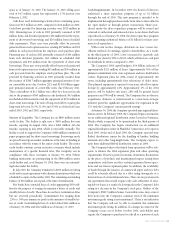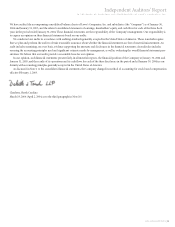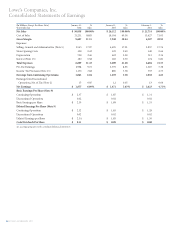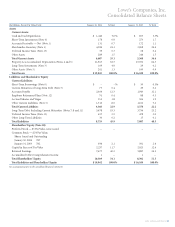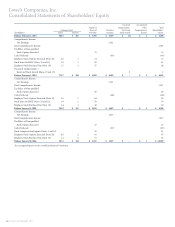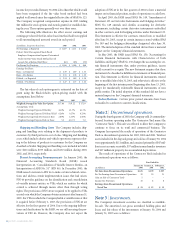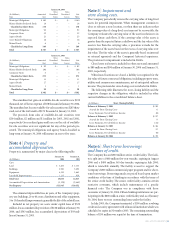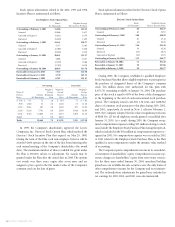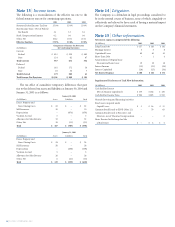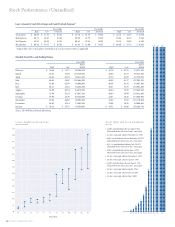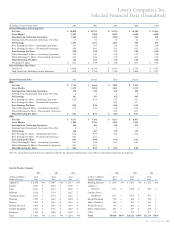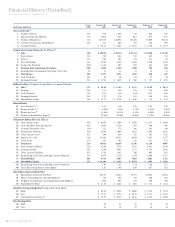Lowe's 2003 Annual Report Download - page 35
Download and view the complete annual report
Please find page 35 of the 2003 Lowe's annual report below. You can navigate through the pages in the report by either clicking on the pages listed below, or by using the keyword search tool below to find specific information within the annual report.
2003 ANNUAL REPORT 33
January 30, 2004
Gross Gross
(In Millions) Amortized Unrealized Unrealized Fair
Type Cost Gains Losses Value
Municipal Obligations $ 160 $ – $ – $ 160
Money Market Preferred Stock 18 – – 18
Classified as Short-Term 178 – – 178
Municipal Obligations 92 – – 92
Corporate Notes 32 – – 32
Agency Bonds 23 – – 23
Asset-Backed Obligations 16 – – 16
Mutual Funds 6 – – 6
Classified as Long-Term 169 – – 169
Total $ 347 $ – $ – $ 347
January 31, 2003
Gross Gross
(In Millions) Amortized Unrealized Unrealized Fair
Type Cost Gains Losses Value
Municipal Obligations $ 82 $ – $ – $ 82
Money Market Preferred Stock 186 – – 186
Corporate Notes 5 – – 5
Classified as Short-Term 273 – – 273
Municipal Obligations 11 – – 11
Agency Bonds 17 – – 17
Mutual Funds 1 – – 1
Classified as Long-Term 29 – – 29
Total $ 302 $ – $ – $ 302
The unrealized net gain on available-for-sale securities was $159
thousand, net of the tax expense of $58 thousand at January 30, 2004.
The unrealized net loss on available-for-sale securities was $285 thou-
sand, net of the tax benefit of $172 thousand at January 31, 2003.
The proceeds from sales of available-for-sale securities were
$204 million, $2 million and $1 million for 2003, 2002 and 2001,
respectively. Gross realized gains and losses on the sale of available-
for-sale securities were not significant for any of the periods pre-
sented. The municipal obligations and agency bonds classified as
long-term at January 30, 2004 will mature in one to five years.
Note 4
|
Property and
accumulated depreciation.
Property is summarized by major class in the following table:
January 30, January 31,
(In Millions) 2004 2003
Cost:
Land $ 3,635 $ 3,133
Buildings 5,950 5,092
Equipment 4,355 3,663
Leasehold Improvements 1,133 929
Total Cost 15,073 12,817
Accumulated Depreciation and Amortization (3,128) (2,465)
Net Property $ 11,945 $ 10,352
The estimated depreciable lives, in years, of the Company’s prop-
erty are: buildings, 20 to 40; store, distribution and office equipment,
3 to 10; leasehold improvements, generally the life of the related lease.
Included in net property are assets under capital lease of $539
million, less accumulated depreciation of $108 million at January 30,
2004, and $543 million, less accumulated depreciation of $93 mil-
lion at January 31, 2003.
Note 5
|
Impairment and
store closing costs.
The Company periodically reviews the carrying value of long-lived
assets for potential impairment. When management commits to
close or relocate a store location, or when there are indicators that
the carrying value of a long-lived asset may not be recoverable, the
Company evaluates the carrying value of the asset in relation to its
expected future cash flows. If the carrying value of the assets is
greater than the expected future cash flows and the fair value of the
assets is less than the carrying value, a provision is made for the
impairment of the assets based on the excess of carrying value over
fair value. The fair value of the assets is generally based on internal
or external appraisals and the Company’s historical experience.
The provision for impairment is included in SG&A.
Closed store real estate is included in other assets and amounted
to $89 million and $94 million at January 30, 2004 and January 31,
2003, respectively.
When leased locations are closed, a liability is recognized for the
fair value of future contractual obligations, including property taxes,
utilities and common area maintenance, net of anticipated sublease
income. The provision for store closing costs is included in SG&A.
The following table illustrates the store closing liability and the
respective changes in the obligation, which is included in other
current liabilities in the consolidated balance sheet.
(In Millions) Store Closing Liability
Balance at February 2, 2001 $ 19
Accrual for Store Closing Costs 6
Lease Payments, Net of Sublease Income (8)
Balance at February 1, 2002 $ 17
Accrual for Store Closing Costs 9
Lease Payments, Net of Sublease Income (10)
Balance at January 31, 2003 $ 16
Accrual for Store Closing Costs 12
Lease Payments, Net of Sublease Income (9)
Balance at January 30, 2004 $ 19
Note 6
|
Short-term borrowings
and lines of credit.
The Company has an $800 million senior credit facility. The facili-
ty is split into a $400 million five-year tranche, expiring in August
2006 and a $400 million 365-day tranche, expiring in July 2004,
which is renewable annually. The facility is used to support the
Company’s $800 million commercial paper program and for short-
term borrowings. Borrowings made are priced based upon market
conditions at the time of funding in accordance with the terms of
the senior credit facility. The senior credit facility contains certain
restrictive covenants, which include maintenance of a specific
financial ratio. The Company was in compliance with those
covenants at January 30, 2004. Fifteen banking institutions are par-
ticipating in the $800 million senior credit facility and, as of January
30, 2004, there were no outstanding loans under the facility.
In July 2003, the Company terminated a $100 million revolving
credit and security agreement with a financial institution which was
scheduled to expire in November 2003. The remaining outstanding
balance of $50 million was repaid at the time of termination.


